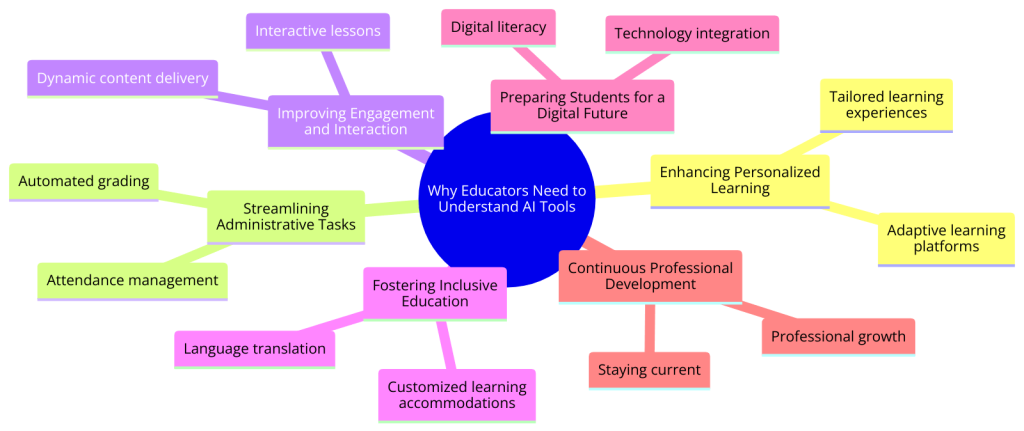In today’s rapidly evolving educational landscape, the best AI tools for teachers are not just nice-to-have additions but essential instruments in enhancing student engagement and fostering a dynamic learning environment. As educators, you constantly face the challenge of capturing and maintaining your students’ attention amidst numerous distractions. Thankfully, artificial intelligence offers groundbreaking solutions that can revolutionize how you teach and how your students learn.
This blog post will delve into the variety of AI tools designed to transform your classroom into a hive of activity and interaction. From tools that customize learning experiences to those that provide real-time feedback and assessments, we will explore how these innovations can help you cater to diverse learning styles and needs. Join us as we uncover the top AI tools that promise to make your teaching more impactful and your students more engaged than ever before. Let’s discover how these tools can not only simplify your teaching tasks but also enrich the educational journey of your students.

If you’re wondering why you should trust this blog over all the others on the subject, read my biography.
AFFILIATE DISCLOSURE: This website uses affiliate links which may earn a commission at no additional cost to you.
WHY EDUCATORS NEED TO UNDERSTAND AI TOOLS
In the rapidly evolving landscape of education, the integration of technology in the classroom has transitioned from a supplementary enhancement to a critical component of effective teaching. Artificial Intelligence (AI) tools, particularly those designed for educational purposes, represent a significant frontier in this evolution. Understanding these tools is not just beneficial but essential for educators who aim to remain effective and relevant in their teaching methods. Here’s why:
Enhancing Personalized Learning
AI tools offer unprecedented capabilities in personalizing the learning experience for students. Tools like adaptive learning platforms analyze student responses and automatically adjust the difficulty of tasks based on individual performance. Educators who understand how to leverage these tools can significantly improve learning outcomes by catering to the unique needs of each student.
Streamlining Administrative Tasks
AI can automate many time-consuming administrative tasks that educators face, such as grading and attendance. By using the best AI tools for teachers, educators can free up more time to focus on teaching and interacting with students rather than managing paperwork. For example, AI tools like Gradescope and TeacherMade facilitate quicker grading and feedback processes, allowing teachers to dedicate more attention to instructional design and student interaction.
Improving Engagement and Interaction
AI tools are not only about efficiency; they also enhance the way educational content is delivered. Tools such as Nearpod and Kahoot use AI to create interactive lessons that are more engaging for students. Educators equipped with these tools can deliver content in a more dynamic and appealing manner, which is crucial for capturing and maintaining student interest in a digital age.

Fostering Inclusive Education
With AI, tools can support language translation, real-time captioning, and customized learning accommodations that help bridge the educational gaps for non-native speakers and students with disabilities. Understanding and using these AI applications can make education more accessible and inclusive, aligning with modern educational standards for equity and diversity.
Preparing Students for a Digital Future
As digital literacy becomes a fundamental skill in the workforce, educators need to integrate technology into their teaching strategies. By incorporating AI tools, teachers not only familiarize themselves with these technologies but also help students acquire the digital skills necessary for future careers. Tools like Canva and Google Classroom integrate AI to streamline content creation and classroom management, preparing students for technology-driven environments.
Continuous Professional Development
Finally, understanding and using AI tools are part of continuous professional development for teachers. Engaging with the best AI tool for teachers allows educators to stay current with educational trends and technological advancements, ensuring they can offer the most effective and modern educational experiences to their students.
Text-to-Speech and AI Writing Tools to Transform Teaching and Learning

In the digital age, technology plays a pivotal role in reshaping educational landscapes, making learning more accessible and engaging for all students. Two significant technological advancements that are making waves in education are text-to-speech (TTS) and AI writer tools. These tools not only support diverse learning needs but also streamline the teaching process, allowing educators to focus on personalized instruction and interactive classroom experiences. Here’s how educators can effectively integrate these tools into their teaching practices.
TTS technology transforms digital text into spoken words, improving accessibility for students with visual impairments or reading disabilities, such as dyslexia, and those who prefer auditory learning. It also supports language learners by providing exposure to correct pronunciation and adjustable speed, enhancing comprehension and pronunciation skills in diverse linguistic classroom settings.
AI writer tools are transforming how educators create instructional materials. By inputting topics and parameters, these tools generate drafts for lesson plans, worksheets, and presentations, which can then be customized to meet specific classroom needs. Additionally, AI tools offer personalized feedback on student assignments by analyzing texts for grammar and style, thereby reducing teachers’ workload and enhancing the learning experience.
Integrating TTS and AI writers fosters a versatile educational environment where written materials are readily available in audio format, supporting various learning styles. This combination is particularly effective in flipped classroom models, where AI-developed materials reviewed at home via TTS allow for more interactive and personalized classroom engagements. This integration not only makes learning more dynamic and engaging but also ensures all students have access to the curriculum in a format that suits their learning preferences.
Let’s see the best text to speech and AI writers tools:
- Murf AI is a versatile AI-powered voice generator that enables the creation of studio-quality voiceovers in minutes. It offers lifelike AI voices for various applications such as podcasts, videos, and professional presentations. With Murf, users can choose from over 120 voices in 20+ languages, and it includes features like pitch control, emphasis adjustment, and syncing with video, music, or images. It’s designed for a range of users, including product developers, educators, marketers, authors, corporate coaches, and podcasters, among others. Murf AI emphasizes ease of use, security, and the ability to produce high-quality, natural-sounding voiceovers rapidly. Read more in our Murf AI review.

- Lovo: Renowned for its artificial intelligence-based voiceover capabilities, Lovo offers more than 50 realistic-sounding voices in various languages. Its intuitive interface makes it an attractive choice for content creators seeking a reliable AI voice generation tool.
- Play.ht is an AI Voice Generator platform offering realistic text-to-speech and AI voiceover services. It uses advanced AI to convert text into natural-sounding human-like voices across various languages and accents. Their products include AI Text to Speech, AI Voice Cloning, and Voice Generation API. Play.ht is used for a wide range of applications such as voiceovers for videos, audio publishing, e-learning, podcasts, gaming, and more. They boast a large library of over 900 AI voices in 142 languages and accents, and their technology supports various speech styles, emotions, character voices, and custom pronunciations. Read more in our Play HT review.
- Speechify operates as an AI-driven text-to-speech application, transforming written text into lifelike vocalizations. It serves a variety of purposes, ranging from aiding individuals with visual impairments to enabling content creators to turn written blog entries into engaging podcast episodes. In contrast, the Speechify Voice Over Studio enhances this experience by providing more sophisticated AI voice options and an intuitive interface, elevating it beyond the standard text-to-speech offerings.
- Scalenut: Scalenut is an AI-powered content creation platform that helps users create high-quality content efficiently. It uses natural language processing (NLP) and machine learning algorithms to generate content based on user inputs. The platform is designed for marketers, bloggers, and content creators who need to produce a large amount of content quickly.
- Rytr: Rytr is an AI-powered writing assistant designed to help users generate written content across various formats and styles. Users can select from a range of use cases, such as blog writing, email drafting, or marketing copy creation, and then specify the tone of voice for the generated content, from formal to casual, or even funny and informative.
- Hypotenuse AI: Hypotenuse AI is an advanced AI writing assistant designed to support a wide range of content creation tasks. It stands out with its extensive template library, catering to various use cases such as blog writing, product descriptions, and even generating AI-powered tweets.
Other Best AI tools for teachers
- Canva Magic Write: Introduced by Canva, Magic Write is an AI-driven tool that converts text into creative visuals. It aids in generating ideas, facilitating brainstorming, and supporting lesson preparation, proving invaluable for educators in crafting presentations and classroom graphics. This tool simplifies various writing tasks by analyzing prompts and aiding in the development of outlines and lesson plans, thereby enhancing the creation of engaging presentations more efficiently.
- Eduaide.Ai: This AI-enhanced educational tool offers teachers access to a diverse array of over 100 resource types for crafting quality educational materials. Eduaide.Ai features instant translation into more than 15 languages and includes a variety of tools such as a syllabus generator, discussion prompt creator, teaching assistant, feedback bot, free-form chat, and an assessment builder.
- OpenAI: OpenAI has released the Teaching with AI guide, designed to aid educators in integrating ChatGPT into their teaching practices. This guide provides detailed prompts, insights into the operation and limitations of ChatGPT, and tips on ensuring information accuracy and bias checking. ChatGPT 4 offers enhanced reliability and accuracy over its predecessors.
- Quizizz: Quizizz enables educators to design quizzes that automatically adapt to individual students’ learning trajectories. This tool has been enhanced with AI capabilities that can modify question difficulty, improve grammar, and tailor questions to mimic real-life situations, with additional functionalities being developed.
Conclusion
In conclusion, the best AI tools for teachers are those that complement and enhance their instructional capabilities, offer streamlined solutions, and foster an inclusive, engaging learning environment. As educators, embracing these tools can lead to more effective teaching and a more rewarding educational journey for students. The journey towards integrating AI into education is ongoing, and staying informed and adaptable is key to harnessing its full potential.
Frequently Asked Questions
Which AI is the Best for Teachers?
Determining the best AI for teachers depends largely on their specific needs and teaching environments. However, AI tools like Gradescope and Kahoot have been widely acclaimed for their versatility across various subjects and grade levels. These platforms enhance engagement through interactive learning and streamline grading processes, making them excellent all-around choices for educators looking to integrate AI into their classrooms.
What is the Best AI Tool for Primary Teachers?
For primary teachers, AI tools that combine educational content with engagement are particularly valuable. Seesaw stands out as a leading option. It is designed to enhance student engagement through interactive lessons and provides a platform for students to showcase their work digitally, which is a great way to involve parents in the learning process. Its user-friendly interface is ideal for young learners, making it a favorite among primary school educators.
What is the Best AI Tool for Teachers Free?
When it comes to free AI tools for teachers, Google Classroom remains a top contender. It facilitates classroom management, supports the distribution and grading of assignments, and integrates seamlessly with other Google services, such as Google Docs and Google Drive. This tool is particularly beneficial for teachers looking for a comprehensive, no-cost solution to help manage their classrooms more efficiently.
What is the Best AI Planner for Teachers?
Trello, enhanced with AI features, is highly recommended for teachers who need robust planning tools. Trello uses AI to help educators organize their lesson plans, track project progress, and manage deadlines and assignments. Its intuitive design and customizable boards allow teachers to plan their curriculum visually and collaborate easily with colleagues, making it an essential tool for staying organized throughout the academic year.







